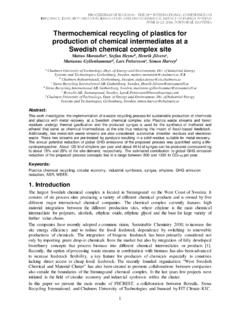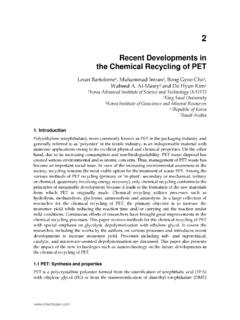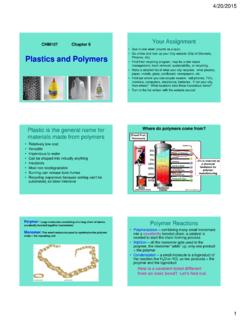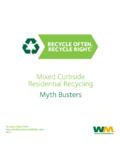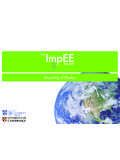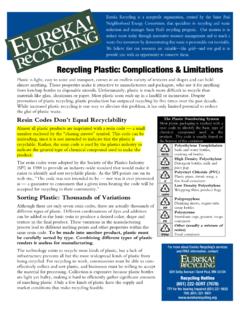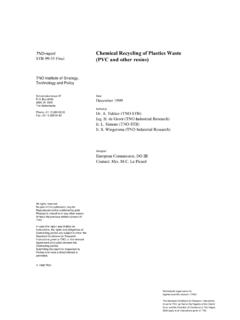Transcription of Plastics: Reduce Use or Recycle? - Monterey Bay Aquarium
1 Monterey BAY Aquarium 2014, Monterey Bay Aquarium Foundation. All rights reserved. plastics : Reduce Use or recycle Page 1 plastics : Reduce Use or recycle ? Focus Question How do we use plastics ? Are there better or worse uses of plastics ? Overview From contact lenses to medical tubing to single-use disposable yogurt containers, plastics are ubiquitous in our daily lives. But how wisely are we using these durable, versatile materials produced from fossil fuels - a nonrenewable resource? In this activity, students examine different kinds of plastics and investigate what happens after plastic objects are thrown in the recycling bin. They are also challenged to think about whether some of the ways we use plastics are better than others. Objectives Students will be able to: Observe and describe the physical and chemical properties that can be used to identify different types of plastics .
2 Differentiate single-use plastics from other plastics . Examine society s use of plastics and recognize that plastic is made from a nonrenewable resource. Background In 2012, the United States generated almost 14 million tons of plastics as containers and packaging, about 11 million tons as durable goods such as appliances, and almost 7 million tons as nondurable goods, such as plates and cups. Only 9 percent of the total plastic waste generated in 2012 was recovered for recycling ( ). Plastic is ubiquitous in our modern world. Plastic is used to make durable items like contact lenses, vehicle parts and electronics. It is also used to make items that are used just once like water bottles, plastic bags, straws and food containers. Plastic is lightweight, durable and relatively economical to manufacture. However, it does not biodegrade; instead it photodegrades into smaller and smaller pieces so it remains in the environment indefinitely.
3 There is a high environmental cost to single-use, disposable plastic; wildlife ingestion and entanglement and habitat alteration are some of the side effects of discarded plastic. In addition, harmful human health effects have been linked to additives in plastics (phthalates and bisphenol A among others). Topic plastics Grades 6-8 Site Indoors, Outdoors Duration 45 minutes Materials see page 2 Vocabulary disposable, fossil fuels, monomer, plastic, polymer, recycle , upcycle Next Generation Science Standards Practices Asking questions and defining problems Core Ideas Structure and properties of matter Human impacts on Earth systems Crosscutting Concepts Structure and function Performance Expectations See page 4 Monterey BAY Aquarium 2014, Monterey Bay Aquarium Foundation. All rights reserved. Page 2 plastics : Reduce Use or recycle ? plastics are primarily synthetic polymers made with chemicals that are derived from nonrenewable fossil fuels, specifically petroleum or natural gas.
4 There are thousands of different kinds of plastics . plastics can be differentiated by certain chemical and physical properties. These properties are surface appearance, transparency, rigidity, density and flammability. The Society of the plastics Industry developed identification codes for six of the most common types and a seventh that includes a number of different plastic types. These are the numbers located in what has come to be called the recycling symbol on plastic objects. It is a misconception that this identification code means the object can be recycled. The codes were developed to help recyclers differentiate between various kinds of plastic. Some plastics are cheaper and less energy intensive to recycle (numbers 1 and 2) while others often don t get recycled at all (number seven). Regardless, recycling is costly in terms of energy and other resources.
5 It is much less costly, both economically and environmentally, to Reduce the amount of plastic used. Every municipality and/or county is different in what it may or may not recycle . Contact your local waste management company for details on recycling in your community. Materials Teacher Preparation 1. A week before the lesson, ask students to bring in a variety of rinsed out plastic objects. Make sure you get a variety of resin identification codes (numbers on each object). Ideally, have five pieces per student group. 2. Make a set of How We Use plastics cards (page 9 and 10) for each student group. You may want to laminate them for reuse with different classes. 3. Decide if you want copies of the Types of plastics student sheet and plastics : Reduce Use or recycle student sheets or if you ll have them use their science notebooks. 4. Check the prezi link to make sure it works.
6 Use the presentation notes on page 7 to run through the presentation before class. Procedure 1. IN SMALL GROUPS, STUDENTS WRITE DOWN EVERYTHING IN THE ROOM MADE OF PLASTIC. Give students 30 seconds to write down everything in the room made of plastics . What kinds of objects are made of plastic? How are they used? Are they used multiple times or only once? Does the plastic all look the same? Feel the same? How many of the items in the room are made of plastic compared to other materials (wood, metal, glass)? VOCABULARY Disposable: a product designed for single use after which it is recycled or disposed of in a landfill Fossil fuels: the remains of plants and animals buried in the Earth s crust and heated and pressurized into crude oil, natural gas, coal and heavy oils Monomer: a molecule that chemically binds to other molecules creating polymers Plastic: an easily-shaped substance made from fossils fuels through chemical reactions Polymer: a large molecule made up of monomers recycle : processing an existing material or product into a different material or product.
7 Uses energy and additional raw materials Upcycle: processing an existing material or product into a higher quality material or product Computer and projector Variety of clean plastic packaging and objects (enough for each student group to have 4-5 pieces) plastics : Reduce Use or recycle prezi (see link in procedure) How We Use plastics cards (one set per student group) plastics : Reduce Use or recycle student sheet (one per student) Types of plastics student sheet (one per student) Monterey BAY Aquarium 2014, Monterey Bay Aquarium Foundation. All rights reserved. plastics : Reduce Use or recycle ? Page 3 2. INTRODUCE THE FOCUS QUESTION TO THE CLASS. Share the question: How do we use plastics ? Are there better or worse uses of plastics ? You may write it up on the whiteboard or have students add it to their science notebook. Give students time to write their initial thoughts down or discuss with a partner.
8 3. STUDENTS CATEGORIZE ILLUSTRATIONS OF A VARIETY OF PLASTIC ITEMS ACCORDING TO HOW WE USE THEM. Pass out a set of How We Use plastics cards to every student group. Have them sort the cards into categories depending on how they are used. Depending on the level of the students, you may have them sort into single-use versus multiple-use or if they have more prior knowledge, wise uses of plastics versus unwise uses of plastics . In their science notebooks, ask them to record the item, what category they placed it in and their reasoning. You may want to model creating a three-column table with item, single-use / multiple-use or wise / unwise and why. 4. STUDENTS EXAMINE AND DIFFERENTIATE A VARIETY OF PLASTIC PACKAGING. Pass out a variety of rinsed plastic packaging with different resin identification codes (RIC). Pose the question: how do we tell different kinds of plastics apart?
9 Give students time to sort them into categories of different plastics . Then solicit ideas from the class on how to tell plastics apart (may range between use, color, number, etc.). Discuss the resin identification codes and how they are an industry code for differentiating plastics but that doesn t always mean the plastic objects are recycled. 5. AS A WHOLE GROUP, DISCUSS THE OBSERVABLE PROPERTIES OF DIFFERENT plastics . Pass out Types of plastics student sheet. Have students examine the plastic objects and record the observable properties of different plastics . If time, you may challenge them to plan an investigation(s) to distinguish between plastic types. The physical and chemical differences can be found by examining surface appearance (smooth, glossy, rough), how light travels through the plastic (transparent, translucent, opaque), rigidity (or flexibility), density and flammability.
10 If you have time, you may choose to do plastics in the Water Column activity which explores density of plastics . (See Resources.) 6. SHARE THE plastics : Reduce USE OR recycle PRESENTATION. Challenge students to think about where plastics come from and how efficiently (in terms of energy and the environment) they are used while sharing the presentation at: See page 8 for the presentation talking points. 7. STUDENTS REASSIGN ILLUSTRATIONS of plastics INTO WISE AND UNWISE USES. Now that students understand that plastics are versatile yet also ultimately nonrenewable and resource-intensive to recycle , ask them to go back and reorganize illustrations of plastics into wise and unwise uses. Have them explain what they mean by wise and why they categorized each illustration as they did. Be sure they understand the difference between single-use disposable plastic and durable uses of plastics .
